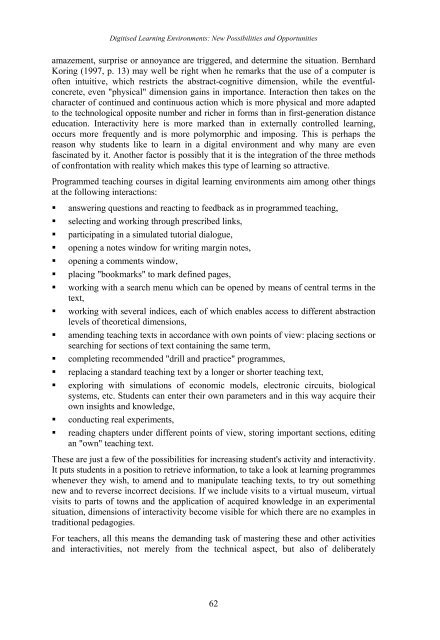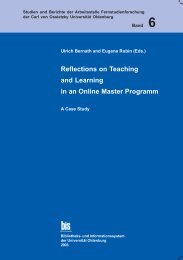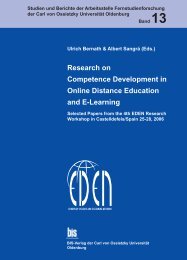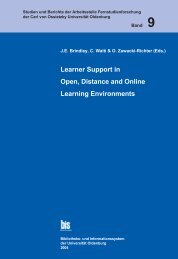Distance Education in Transition - Master of Distance Education ...
Distance Education in Transition - Master of Distance Education ...
Distance Education in Transition - Master of Distance Education ...
You also want an ePaper? Increase the reach of your titles
YUMPU automatically turns print PDFs into web optimized ePapers that Google loves.
Digitised Learn<strong>in</strong>g Environments: New Possibilities and Opportunities<br />
amazement, surprise or annoyance are triggered, and determ<strong>in</strong>e the situation. Bernhard<br />
Kor<strong>in</strong>g (1997, p. 13) may well be right when he remarks that the use <strong>of</strong> a computer is<br />
<strong>of</strong>ten <strong>in</strong>tuitive, which restricts the abstract-cognitive dimension, while the eventfulconcrete,<br />
even "physical" dimension ga<strong>in</strong>s <strong>in</strong> importance. Interaction then takes on the<br />
character <strong>of</strong> cont<strong>in</strong>ued and cont<strong>in</strong>uous action which is more physical and more adapted<br />
to the technological opposite number and richer <strong>in</strong> forms than <strong>in</strong> first-generation distance<br />
education. Interactivity here is more marked than <strong>in</strong> externally controlled learn<strong>in</strong>g,<br />
occurs more frequently and is more polymorphic and impos<strong>in</strong>g. This is perhaps the<br />
reason why students like to learn <strong>in</strong> a digital environment and why many are even<br />
fasc<strong>in</strong>ated by it. Another factor is possibly that it is the <strong>in</strong>tegration <strong>of</strong> the three methods<br />
<strong>of</strong> confrontation with reality which makes this type <strong>of</strong> learn<strong>in</strong>g so attractive.<br />
Programmed teach<strong>in</strong>g courses <strong>in</strong> digital learn<strong>in</strong>g environments aim among other th<strong>in</strong>gs<br />
at the follow<strong>in</strong>g <strong>in</strong>teractions:<br />
� answer<strong>in</strong>g questions and react<strong>in</strong>g to feedback as <strong>in</strong> programmed teach<strong>in</strong>g,<br />
� select<strong>in</strong>g and work<strong>in</strong>g through prescribed l<strong>in</strong>ks,<br />
� participat<strong>in</strong>g <strong>in</strong> a simulated tutorial dialogue,<br />
� open<strong>in</strong>g a notes w<strong>in</strong>dow for writ<strong>in</strong>g marg<strong>in</strong> notes,<br />
� open<strong>in</strong>g a comments w<strong>in</strong>dow,<br />
� plac<strong>in</strong>g "bookmarks" to mark def<strong>in</strong>ed pages,<br />
� work<strong>in</strong>g with a search menu which can be opened by means <strong>of</strong> central terms <strong>in</strong> the<br />
text,<br />
� work<strong>in</strong>g with several <strong>in</strong>dices, each <strong>of</strong> which enables access to different abstraction<br />
levels <strong>of</strong> theoretical dimensions,<br />
� amend<strong>in</strong>g teach<strong>in</strong>g texts <strong>in</strong> accordance with own po<strong>in</strong>ts <strong>of</strong> view: plac<strong>in</strong>g sections or<br />
search<strong>in</strong>g for sections <strong>of</strong> text conta<strong>in</strong><strong>in</strong>g the same term,<br />
� complet<strong>in</strong>g recommended "drill and practice" programmes,<br />
� replac<strong>in</strong>g a standard teach<strong>in</strong>g text by a longer or shorter teach<strong>in</strong>g text,<br />
� explor<strong>in</strong>g with simulations <strong>of</strong> economic models, electronic circuits, biological<br />
systems, etc. Students can enter their own parameters and <strong>in</strong> this way acquire their<br />
own <strong>in</strong>sights and knowledge,<br />
� conduct<strong>in</strong>g real experiments,<br />
� read<strong>in</strong>g chapters under different po<strong>in</strong>ts <strong>of</strong> view, stor<strong>in</strong>g important sections, edit<strong>in</strong>g<br />
an "own" teach<strong>in</strong>g text.<br />
These are just a few <strong>of</strong> the possibilities for <strong>in</strong>creas<strong>in</strong>g student's activity and <strong>in</strong>teractivity.<br />
It puts students <strong>in</strong> a position to retrieve <strong>in</strong>formation, to take a look at learn<strong>in</strong>g programmes<br />
whenever they wish, to amend and to manipulate teach<strong>in</strong>g texts, to try out someth<strong>in</strong>g<br />
new and to reverse <strong>in</strong>correct decisions. If we <strong>in</strong>clude visits to a virtual museum, virtual<br />
visits to parts <strong>of</strong> towns and the application <strong>of</strong> acquired knowledge <strong>in</strong> an experimental<br />
situation, dimensions <strong>of</strong> <strong>in</strong>teractivity become visible for which there are no examples <strong>in</strong><br />
traditional pedagogies.<br />
For teachers, all this means the demand<strong>in</strong>g task <strong>of</strong> master<strong>in</strong>g these and other activities<br />
and <strong>in</strong>teractivities, not merely from the technical aspect, but also <strong>of</strong> deliberately<br />
62





